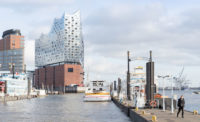Colmar, France
The picturesque Alsatian village of Colmar is a rare gem; throughout the destructions of the French Revolution, the two world wars, and the various territory disputes over Alsace between Germany and France, Colmar’s medieval timber rowhouses and Gothic cathedrals remained intact. Rumor has it that the quaint town inspired the architecture in Disney’s animated film Beauty and the Beast. But in a recent renovation of the city’s Musée Unterlinden, Herzog & de Meuron made a conscious effort to avoid the preciousness of a Disney film.
In late January, the Swiss firm completed an extensive six-year expansion of the museum in collaboration with chief architect of French National Monuments Richard Duplat. Unterlinden and its collection of early-Renaissance works had occupied the same cloistered 13th-century Dominican convent since its founding in 1849, but after several sizable donations of modern art over the years, the collection began to outgrow its home. Seeking more space, the museum acquired the early-20th-century neo-baroque indoor swimming pool across the street in 2003. And in 2009, Unterlinden launched a design competition seeking an architect who could integrate this unusual new space with its existing structures.
One of the main challenges of the project was to honor the original architecture “without falling into the trap of postmodern kitsch,” says Herzog & de Meuron senior partner Jacques Herzog. To create a foil in size and scale to the convent’s centuries-old chapel, where the early- Renaissance collection still resides, the firm designed the Ackerhof. This new wing for modern art, placed behind the bathhouse, is clad in rough-hewn, hand-split bricks and has a copper roof. In contrast to the chapel’s soaring, groin-vaulted ceiling and heavily ornamented interiors, however, the Ackerhof has been divided into three floors of pristine white modern galleries. The roof, not vaulted like the convent, encloses a top-floor gallery under a gable.
The two buildings bookend the newly expanded Unterlinden campus, but its core required some urban intervention. When the architects arrived, the pool house and convent were separated by a bus stop and parking lot. To create a new urban public space, they unearthed the previously covered Sinn Canal, which now marks a boundary between the nearly symmetrical old and new wings. They lined the canal’s banks with limestone steps ideally suited for picnics.
For visitors, the circulation path begins at the convent, whose lancet doorway has been resituated to face the new public square. In the entrance hall and bookshop, the architects undid aesthetically unsympathetic interventions, peeling away layers of plaster ceiling to re-expose medieval wood beams. Throughout, new lancet windows invoke a recurring medieval architectural form seen both in the original doorway and in the ornate gothic arches of the convent’s cloisters.
Refurbished galleries lining the perimeter of the cloisters lead visitors to the convent’s chapel, which houses Unterlinden’s pièce de résistance: Matthias Grünewald’s carefully preserved 1516 Isenheim Altarpiece, which no sits under a new roof and on top of a refurbished oak floor.
From there, visitors descend a new cast-in-place concrete spiral staircase to enter a subterranean gallery. The rectangular corridor traces a loosely chronological history of French modern art that leads to another spiral staircase waiting at the opposite end, and ascends into the Ackerhof, where the museum’s powerhouse collection of works by Picasso, Dubuffet, Delaunay, and others, hangs from what they call “floating picture walls”: partitions which stop short of the floor and ceiling that are supported by slender cylindrical posts. The resulting airiness is a departure from the stone and brick of the convent.
The Ackerhof adjoins the former bathhouse, home to the museum’s administrative offices, library, and coffee shop. Under the stained-glass skylights of the central atrium, the parquet floor of a new event space inhabits the footprint of the former swimming pool.
Subtle references like this abound, most poignantly in la Petite Maison, a copper-roofed allusion to an ancient mill that stood adjacent to the bathhouse until the 1960s. The ground-floor slab has been omitted so that the diminutive structure can funnel daylight through its windows and into a lower gallery where the museum’s modern and religious artwork intersect. The “little lantern,” as the architects call it, unites past and present, aboveground and below.
The overall intervention is three-pronged, combining architecture with urban intervention and a bit of curatorial choreography, all infused with metaphor. The architects have demonstrated a thorough understanding of the site’s history, down to the historical context of individual pieces within the collection. As such, they’ve managed to build a modern institution firmly rooted in medieval heritage, but have avoided building, what Herzog describes as “a medieval Disney World.”
PeopleArchitect:
Herzog & de Meuron
Personnel in architect's firm who should receive special credit:
Partners: Jacques Herzog, Pierre de Meuron, Christine Binswanger (Partner in Charge) Associate architect: DeA Architectes, Mulhouse, France
Engineers:
General Planning: Herzog & de Meuron SARL, France
Consultants Acoustical: Echologos, Livry-Louvercy, France Landscape: Cap Vert Ingénierie, Grenoble Lighting: Arup, London, UK
Photographer: Ruedi Walti
Client: City of Colmar, France
Size: 83,000 square feet
Cost: $54 million
Completion Date: December 2015 |
ProductsBrick Gima
Tile Topcer
Oak Floors: Singer Parquets
Lighting Artemide, Regent, Salvi, Flos |













Post a comment to this article
Report Abusive Comment